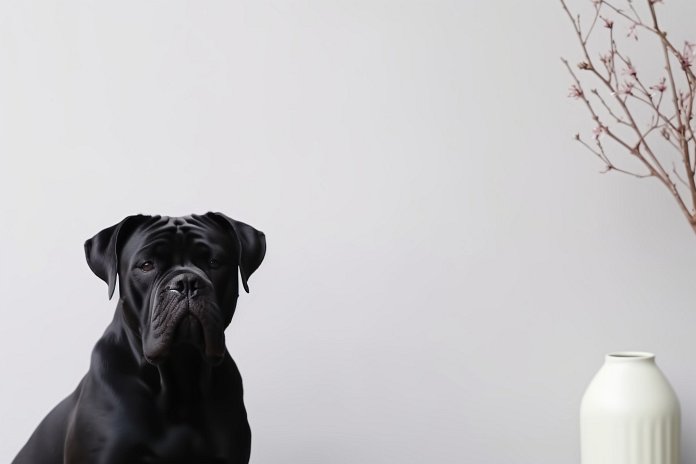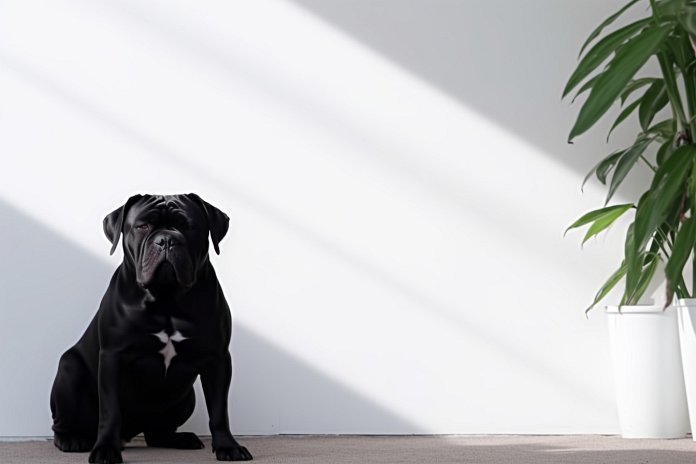
The Cane Corso is a breed believed to have descended from the Roman Molossian, also known as the Canis Pugnax. They were originally bred in Italy and were primarily used as guard and hunting dogs. The name of the breed comes from the Latin word “cohors,” meaning “protector” or “guardian.” In the past, the Cane Corso faced extinction, but efforts were made to save the breed by introducing crossbreeding and other breeds to expand their gene pool, which helped improve their overall health.
These dogs are medium to large in size and can weigh up to 110 pounds. They are known for being highly trainable and attentive, making early obedience and socialization training important. Cane Corsos generally have a calm and friendly demeanor towards their owners and are good with children. However, they can be cautious and occasionally aggressive towards strangers. Due to their athletic nature, Cane Corsos enjoy activities like running and hiking. With a secure home, they can adapt well to either indoor or outdoor living.
Below, we look at Cane Corso dog breed, its history, personality, pros and cons of owning an Cane Corso, characteristics, and must-know facts. We will also examine how to care for this breed and much more. Prepare for a tail-wagging adventure into the world of Cane Corsos!
| Dog Breed | Cane Corso |
| Size | Large |
| Weight | 88-99 lbs (average) |
| Height | 23-25″ (average) |
| Location | Italy |
| Ancestry | roman molassian |
| Date of Origin | unknown |
| Group | Hunting, Guard Dog |
| Life Expectancy | 10-12 years |
| Price | $1500 – $2000 |
| Family | Canidae |
| Scientific Name | Canis Lupus Familiaris |
📖 Breed History
The Cane Corso is a breed of dog that originated in Italy and is part of the Mastiff family. It can trace its roots back to the Roman war dogs. After the decline of the Roman Empire, the Cane Corso took on various roles such as farmhand, flock guardian, property guardian, family guardian, and hunting dog. It was particularly skilled at hunting big and dangerous game like wild boar.
Unfortunately, the breed faced a decline with the rise of industrialization and nearly became extinct after the two World Wars. By the 1970s, only a few Cane Corsos were left in remote areas of southern Italy. It wasn’t until 1973 that Dr. Paolo Breber became aware of the breed through Giovanni Bonnetti, who remembered seeing these dogs during his youth. Dr. Breber started a breeding program the following year and by 1996, the breed gained recognition from the Federation Cynologique Internationale.
During this time, some Cane Corsos were also brought to the United States. The International Cane Corso Federation was established in the U. S. in 1993, leading to the importation of more dogs from Italy. In 2003, the ICCF decided to seek recognition for the breed from the American Kennel Club and changed its name to the Cane Corso Association of America. Finally, in 2010, the breed gained recognition from the American Kennel Club.

🐕 Cane Corso Appearance
Large and strong, the Cane Corso may weigh up to 120 pounds. He has a rectangular-shaped, massive torso, and a huge head. Although he has a robust physique, he also has long, graceful muscles. The Cane Corso has a powerful, slightly arched neck and a very deep, wide nose. A variety of colors are available for this breed, including black, red, plumb-gray, slate, light fawn, deer fawn, light gray, and gray. The Cane Corso has short hair that gets thicker as the seasons change. Dogs can have cropped or uncropped ears.
| 👀 Eye Color | Brown |
| 🐽 Nose Color | Black, Brown |
| 🐕 Coat Color | Black, Gray, Red, Fawn |
⚡ Fun Fact: Cane Corso dogs are a social breed. They enjoy being around people or other animals. This breed doesn’t tolerate being left alone.
🐶 Traits & Temperament of Cane Corso
The Cane Corso is a clever, outspoken, and confident breed. The breed’s canines are extremely devoted and have even, steady temperaments. It is advised that socialization and training begin at a young age. The owner must assert himself or herself as the pack leader and take command since the breed has a natural propensity to be the boss. Boundaries must be set with confidence because the dog will almost certainly challenge them. The Cane Corso gets along well with kids and may get along with other dogs under supervision. The Cane Corso will benefit from regular exercise to maintain his physical and emotional well-being; he will appreciate running alongside his owner or going on lengthy walks. The breed’s dogs make excellent guard dogs, and while they are often calm and affectionate with their owners, they frequently display aggressive and distrustful behavior against outsiders.
🤝 Are Cane Corsos Friendly or Aggressive?
Cane Corso dogs are happiest when they are the sole pet in the family. They are not known to be friendly towards strangers and may need time to warm up to new people. While they are generally friendly towards children, it is important to supervise their interactions to ensure safety. Cane Corsos are not typically cat-friendly and may not get along well with other feline companions. However, they have an average level of friendliness towards other dogs. Additionally, Cane Corsos often get along well with elderly people.
This breed is known for being:
- Courageous
- Loyal
- Social
- Cheerful
- Quiet
🐩 Cane Corso Care & Maintenance
The Cane Corso, a breed that is said to shed little, needs little maintenance. His short hair should be cleaned frequently with a soft bristle brush to remove dead hair, and he should have his nails cut as needed using a nail clipper or grinder to prevent them from becoming too long and splitting. Regular inspection of the Cane Corso’s ears is necessary to ensure that wax and debris don’t accumulate and cause an infection. The breed’s oral health must be maintained with frequent tooth cleaning. The Cane Corso needs regular exercise because it is an energetic breed. The breed will do well in an apartment provided he has the opportunity to receive adequate exercise, but access to a fenced-in outside yard is essential. If he has access to a secure shelter, the Cane Corso may also live contentedly outside. Bloat and other potentially expensive medical issues are frequent in cane corsos. To prevent exorbitant veterinarian care costs, get pet health insurance right now. You may compare policies from renowned firms like Figo and Spot using our tool for pet insurance. With only a few clicks, find your pet’s “pawfect” plan!
Cane Corso dogs have a moderate shedding tendency, which is a normal part of their hair growth cycle. Regular brushing can help minimize the amount of hair that is shed. The extent of shedding can vary depending on the dog’s overall health and the specific breed characteristics. It is recommended to give them a bath every 4-6 weeks to keep their coat clean and healthy.
🍖 Food: We recommend 3 cups daily, costing you about $1.50 – $1.90 daily, or roughly $39.00 – $52.00 a month.
🐾 Exercise: Cane Corso dogs have an average exercise need. This breed is satisfied with short walks every weekday and a long ones on weekends.
This dog breed requires to be walked for roughly 10 miles per week, which equates to about 60 minutes of physical activity daily. This consistent moderate exercise regimen will help maintain their physical wellness and significantly contribute to their mental stimulation. Consciously setting aside this time for your furry friend can dramatically enhance their life quality, helping them stay energetic, healthy, and mentally alert.
Did you know: Cane Corso dogs have a higher energy level than other dog breeds. If you want a dog for snuggling on the couch, this breed isn’t the perfect choice for you.
❤️🩹 Cane Corso Health & Issues
Some of the major concerns for Cane Corso Dog Breed can be:
- Bloat
While minor concerns include:
- Bone And Joint Problems
🤧 Important: Is Cane Corso hypoallergenic? No.
✨ Bonus: Check out cool, creative, and funny names for Cane Corso.
⚡ Cane Corso Dog Breed Facts
What makes the Cane Corso a great choice for families with young children?
The Cane Corso’s calm and friendly nature makes them a great choice for families with young children. They are known to be good with kids and are usually patient and gentle around them.
Is the Cane Corso breed considered a suitable breed for apartment living?
The Cane Corso is not considered a suitable breed for apartment living due to its size and energy level. They require a lot of space to move around and regular exercise to stay healthy and happy.
How much exercise does a Cane Corso require compared to other breeds?
The Cane Corso requires a significant amount of exercise compared to other breeds. They are active dogs and need daily runs, long walks, or hikes to fulfill their physical and mental needs.
Is the Cane Corso breed known for being good with other pets?
The Cane Corso can be good with other pets when properly supervised and introduced. Early socialization and training are important to ensure they get along well with other animals.
What are other low-maintenance dog breeds similar to the Cane Corso?
Some low-maintenance dog breeds similar to the Cane Corso include the Bullmastiff, Boxer, and Rottweiler. These breeds also have protective instincts and are generally easy to care for.
What are the common health issues that Cane Corsos are prone to?
Common health issues that Cane Corsos are prone to include hip dysplasia, elbow dysplasia, bloat, and cherry eye. Regular vet check-ups and a healthy diet are important for their overall well-being.
Are Cane Corsos known to be easy to train compared to other breeds?
Cane Corsos are generally considered easy to train compared to other breeds. They are intelligent and responsive, making them highly trainable with consistent and positive reinforcement methods.
Are Cane Corsos more prone to separation anxiety compared to other breeds?
Cane Corsos can be prone to separation anxiety, especially if not properly trained and socialized from an early age. They thrive on human companionship and may become anxious when left alone for long periods.
Are there any dog breeds similar to the Cane Corso that are suitable for people with allergies?
There are no dog breeds similar to the Cane Corso that are specifically known for being suitable for people with allergies. However, some hypoallergenic breeds like the Poodle or Bichon Frise may be better options for individuals with allergies.
What sizes of dogs similar to the Cane Corso are best for individuals or families with limited space?
For individuals or families with limited space, smaller-sized breeds similar to the Cane Corso, such as the Staffordshire Bull Terrier or the American Bulldog, may be more suitable.
Is the Cane Corso breed known to be good with children with special needs?
The Cane Corso breed can be good with children with special needs, as they are generally patient and gentle. However, it is important to supervise interactions and ensure proper training and socialization.
How does the grooming and shedding needs of the Cane Corso?
The grooming needs of the Cane Corso are moderate. They have a short coat that requires regular brushing to minimize shedding. They are not considered heavy shedders compared to some other breeds.
We use reliable and publicly available data and resources such as AKC and American Canine Registry to ensure that Cane Corso dog breed information is accurate and up to date. If you spot an error, please don’t hesitate to bring it to our attention.